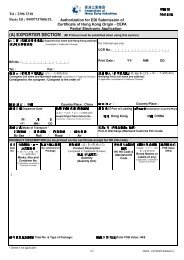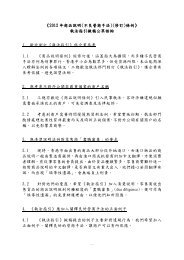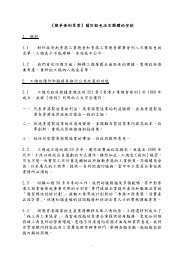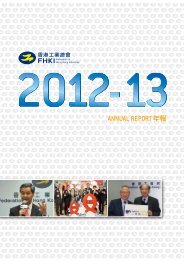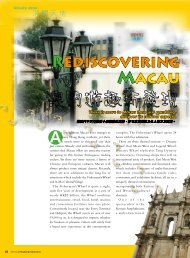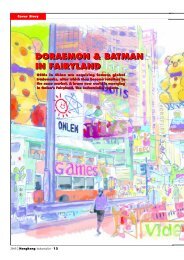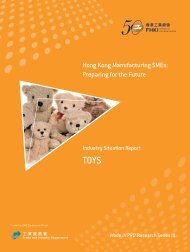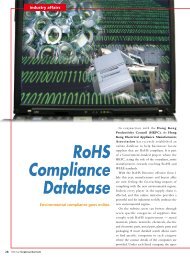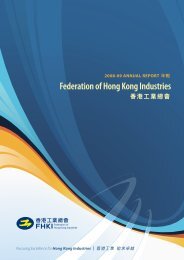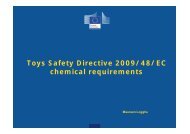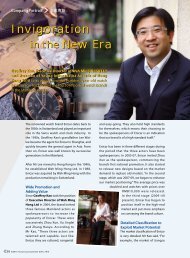Hong Kong Manufacturing SMEs: Preparing for the Future
Hong Kong Manufacturing SMEs: Preparing for the Future
Hong Kong Manufacturing SMEs: Preparing for the Future
- No tags were found...
Create successful ePaper yourself
Turn your PDF publications into a flip-book with our unique Google optimized e-Paper software.
68In 2009, <strong>Hong</strong> <strong>Kong</strong> imported textile and clothingsector traded goods of HK$197.7 billion or 7.3 percent of total imports. This was down 17.8 per centfrom 2008.Issues <strong>for</strong> <strong>Hong</strong> <strong>Kong</strong> Garment ManufacturersThe major issues facing <strong>Hong</strong> <strong>Kong</strong> garment firmsoperating in <strong>the</strong> PRD are rising operating costs, ashortage of skilled workers, a decrease in ordersfrom overseas buyers, competition from o<strong>the</strong>rdeveloping countries, increased order frequency,reduced individual order volume, changing styles,a demand <strong>for</strong> speedier delivery, higher qualitydemands from end customers, and <strong>the</strong> appreciationin <strong>the</strong> RMB. Competition in <strong>the</strong> garment industrywithin China and between China and o<strong>the</strong>rlocations is intensified by low entry barriers.The impact of <strong>the</strong> global economic slowdown canbe seen in that Chinese Customs reported that <strong>the</strong>garment exports from China fell by 9.8 per cent fromUS$185.3 billion in 2008 to US$167.1 billion in 2009.<strong>Hong</strong> <strong>Kong</strong>’s garment business was greatly affectedby <strong>the</strong> downturn, with total exports, total imports,and re-exports of textiles and clothing seeing doubledigit declines in 2009. China’s garment exportsstarted to grow again during <strong>the</strong> latter part of 2009.However, retailers’ confidence remained fragile,and <strong>the</strong>y have been reducing <strong>the</strong>ir working capitalby placing smaller order volumes and demandingquicker delivery times at cheaper prices. 130130 “HK exporters in Pearl River Delta win more orders,” SouthChina Morning Post, 27 May 2009.131 english.tianhechem.com.132 Interview with <strong>the</strong> leadership of Federation of <strong>Hong</strong> <strong>Kong</strong>Industries, 31 March 2010.The garment industry is labour-intensive. Thismeans that it is hit disproportionately by increasesin labour costs in China and is more subject tocompetition from low wage nations than o<strong>the</strong>rsectors. China has had a labour cost advantagethat helped it compete in <strong>the</strong> industry. Increasingly,however, lower labour costs can be found in o<strong>the</strong>rdeveloping nations, though China still benefits frommassive scale, a huge home market, and establishedgarment and textile production chains.In addition, <strong>the</strong>re is a shortage of skilled workersin <strong>the</strong> sector in <strong>the</strong> PRD. The manpower shortageacross <strong>the</strong> economy in areas such as Guangzhou,Shenzhen, and Zhuhai was estimated at morethan two million in early 2010, 131 <strong>for</strong>cing garmentfactories to reduce production. The GuangdongLabour and Social Security Bureau increased <strong>the</strong>minimum wage effective from 1 May 2010. Mostof <strong>the</strong> <strong>Hong</strong> <strong>Kong</strong> factory owners we interviewedthought <strong>the</strong> new measure would be of little helpin attracting more migrant workers as manymanufacturers still face labour shortages even afterpaying <strong>the</strong>ir employees more than <strong>the</strong> amountthat <strong>the</strong> government requires. 132 Fur<strong>the</strong>r, increasesin labour costs have a significant impact onprofitability and even <strong>the</strong> viability of <strong>the</strong> business,and on <strong>the</strong> competitiveness of <strong>the</strong> PRD in <strong>the</strong>industry.The garment industry was one of <strong>the</strong> industriessingled out <strong>for</strong> greater restrictions on exportprocessing and reduced VAT rebates in China in2006 and 2007 on <strong>the</strong> grounds that <strong>the</strong> garmentindustry was too labour and resource intensive. Thedyeing sector, a key component of <strong>the</strong> garmentsector, has been singled out as a polluting industrythat also requires restrictions. This has <strong>the</strong> potentialto disrupt a key step in <strong>the</strong> supply chain.



